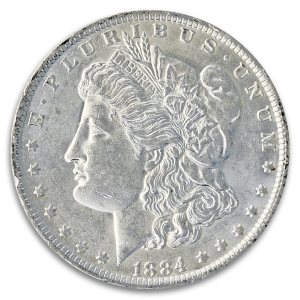1915-S $20 Saint Gaudens PCGS MS64 CAC









This Type underwent two significant alterations and two relatively minor adjustments. The first major modification occurred in 1908 when the motto IN GOD WE TRUST was introduced to the reverse, positioned just above the sun. The second significant change transpired in 1912 when New Mexico and Arizona achieved statehood, necessitating the addition of two stars to the obverse design, thereby increasing the total number to 48 stars. These new stars found their place at the lower right end of the arc pattern of stars.
In 1908, minor tweaks were implemented, including an increase in the number of eagle tail feathers from eight to nine and a reduction in the number of rays on the reverse from 34 to 33.
The incorporation of the motto into our coinage was championed by Reverend Mark R. Watkinson of Ridleyville, Pennsylvania. The profound religious sentiments stirred by the uncertainties and horrors of the Civil War prompted Rev. Watkinson to advocate for its inclusion. Secretary of the Treasury, Salmon P. Chase, concurred with this sentiment and, utilizing his discretion regarding coin inscriptions, initiated the inclusion of the motto on the 2-cent piece in 1864. Originally, the motto was intended to read as "In God Our Trust," but Chase's connection to his alma mater may have influenced the final wording. Secretary Chase was an alumnus of Brown University, whose motto IN DEO SPERAMUS translates to "IN GOD WE HOPE." It is believed that Chase had this in mind when determining the exact wording of the motto. The Coin Act of March 3, 1865, granted the Treasury the discretionary power to incorporate the motto "on all coins able to accommodate it," referring to coins of sufficient size to include the motto. The Mint interpreted this directive to encompass all silver coins larger than a dime, half eagles, eagles, and double eagles. It wasn't until 1908 that Congress mandated the inclusion of the motto on gold and silver coins. Subsequently, in 1955, Congress passed legislation that enforced the presence of the motto on all coins.
Saint-Gaudens Double Eagles are collected in various ways. Some collectors opt for a single high-grade specimen. More advanced collectors and investors embark on the challenging journey of assembling complete sets based on date and mintmark, an endeavor demanding substantial financial resources and patience. Given that this coin was minted in Philadelphia, Denver, and San Francisco, many collectors acquire one from each of these Mints. Bullion enthusiasts often seek out lower-grade pieces as a safeguard against inflation. Notably, coins minted in 1933 were never officially released into circulation, rendering any such coins subject to government confiscation.
A LITTLE STICKER MAKES A BIG DIFFERENCE.
Within each number of the coin grading scale is a small range of condition from low-end to high-end. Certified coins of the same grade can be of varying quality. Many of today’s collectors want coins that are solid or premium quality for their assigned grade. CAC holds coins to a higher standard so you can be confident in the value of yours. We verify previously graded coins … and award our sticker only to those coins that meet the standard for today’s selective buyer.
WHAT THE CAC STICKER MEANS:
- Verified. Your coin has been verified as meeting the standard for strict quality within its grade.
- Guaranteed. CAC stands behind our verification.
THE CAC STICKER IS BACKED BY EXPERIENCE.
CAC was founded by leading members of the numismatic community, including John Albanese, a respected authority on coin grading and the rare coin market.






 Quick View
Quick View





